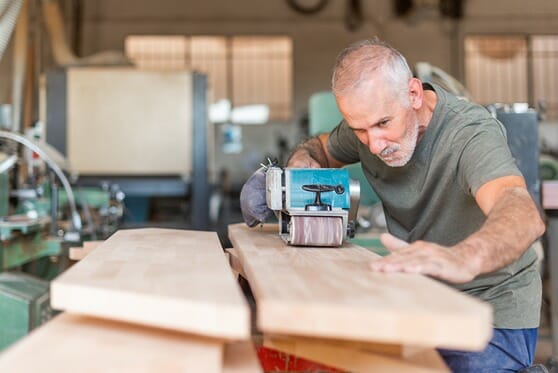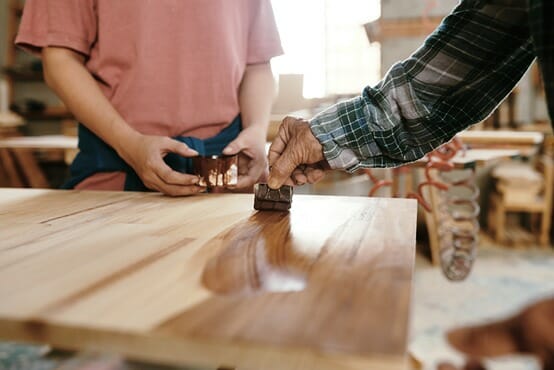Can You Sand Engineered Wood? It depends; with some care, it’s possible. Engineered wood like Hardwood plywood has become quite popular in recent years as it’s often cheaper than solid wood, easy to cut and manipulate, and doesn’t need to be finished with varnish or stain.
The biggest question with engineered wood, however, is whether or not you can sand it down if the surface gets damaged or starts to wear out over time. The answer might surprise you! Here are some reasons you can sand engineered wood and why this might be a good idea in certain situations.
Can you sand engineered wood?
Let’s dive in to know Can You Sand Engineered Wood? Not all engineered wood is created equal. Some grades of engineered wood are more sandable than others. Before you start sanding, there are two things you need to understand about how to treat your project’s engineered wood: its moisture content and the quality of veneer.
Let’s look at each in turn.
● First, moisture content. Moisture levels can vary greatly between brands and even within a brand. This means that one sheet might be much easier to sand than another sheet of the same product line, even if they have identical surfaces (more on that later).
If you don’t know your moisture level, it’s best to play it safe and avoid any heavy-duty sanding until you do. Once you know your moisture level, plan on letting it sit for a week or so before attempting any serious sanding work. It will dry out during that time and make subsequent sanding much easier and safer for both your tool and surface finishes.
● Regarding veneer quality, most companies use high-quality veneers with their products. But not all high-quality veneers are created equally. For example, some products may use solid hardwood, while others may use laminate pieces glued together with plywood backing sheets.
Those latter products tend to chip easily when sanding and aren’t recommended for heavy-duty sanding jobs like those required by many furniture projects. Solid hardwood panels tend to hold up better under pressure but still shouldn’t be subjected to too much abuse without first testing them yourself with an ultra-fine grit paper like 120 grit or higher, depending on your desired finish result.
What is Engineered Wood? Can You Sand Engineered Wood
Lumber is mainly classified into two types: solid wood and engineered wood. Solid wood pieces are typically made from one solid piece of timber. In contrast, engineered wood products use more than one type of material to create a thicker and longer piece of lumber with less chance of warping or cracking. It’s lighter yet stronger than regular hardwood boards because it comprises softwood fibers bonded with synthetic resins, glues, or adhesives.

Not all wood is created equal, especially when it comes to sanding. Solid and plywood are two common types of engineered wood flooring. Solid wood is easy to sand because it’s one piece of solid material, but engineered wood is not so simple.
Engineered woods are glued together with other materials, making them three-dimensional objects with many surfaces and edges to navigate around. Luckily, there are ways you can work with your floor without ruining it or endangering yourself. Let’s take a look at some tips for sanding engineered wood floors.
A few things to remember about sanding engineered wood before we begin:
● First, check your manufacturer’s instructions for any specific directions on how best to handle your floor. Some will have special requirements (such as using coarser paper) that may be important to follow if you want your finished product to be durable and long-lasting.
● Second, make sure that both yourself and anyone working on the project wear safety goggles during sanding sessions – particles from older finishes may become airborne during sanding projects, irritating or even injury if they get into the eyes.
● Finally, never use an electric sander on an engineered wood floor – doing so could cause damage to your floor or lead to electrical hazards.
Steps while sanding Engineered Wood
Use the following steps to get better results.
Step 1: Use Coarse Paper
When sanding an engineered wood floor, start with coarse paper designed specifically for stripping paint and varnish off wooden surfaces. If you’re unsure whether or not your home improvement store carries such papers, ask a sales associate who should be able to point you in the right direction.
Step 2: Go With Medium Paper Next
Once most of the old finish has been removed from your surface, switch over to medium-grit sandpaper, which will remove any remaining remnants while smoothing out rough spots left behind by coarse paper.
If you’re working with a large area that requires more than one sheet of sandpaper, make sure you use a separate piece for each section. Switching to a new piece of sandpaper in between sections ensures that your finished product is as smooth and even as possible.
Step 3: Finish Up With Fine Paper
Once all previous coatings have been removed and all rough spots have been eliminated, it’s time to move on to fine-grit sandpaper (if you haven’t already). As before, changing papers frequently helps ensure an even final result without leaving tiny bumps or dips on your floor’s surface. And don’t forget about safety goggles; they should be worn during sanding projects!
Reasons Not To Seal An Engineered Wood Floor

If you’re considering sealing an engineered wood floor, there are a few reasons why you should think twice. Compared to your typical hardwood floors, engineered wood floors do not hold up well to moisture, making them unsuitable for applications like bathrooms and basements. In addition, they tend to be much thinner than hardwood flooring, which results in less durability over time.
Ultimately, if you want to seal your engineered wood floor, it’s best to consult a professional who can assess whether or not it will hold up well over time. Otherwise, your sealed surface will likely start cracking within months of installation. Consider all angles when making such a big decision before proceeding with any measures that might damage your new investment in floors.
You can also check out our other related article Sanding a Deck with a Floor Sander:
Factors that affect how often you can sand engineered wood
It’s easy to sand hardwood floors, but with engineered wood floors, it’s not as straightforward. Several factors will affect how often you can sand an engineered wood floor. These factors include the type of sanding, what you’re using to sand the floor, how clean your tools are, and how well you protect the floors from moisture and debris before and after sanding.
Read on to learn more about these factors and how they affect your ability to sand your engineered wood floor.
Species
The type of wood will affect how frequently it needs to be sanded. Certain species, like oak, are known for their high propensity to splinter, creating rough edges and grain patterns. This necessitates more maintenance than others. Additionally, certain types of wood age better than others. For example, redwood tends to last longer than pine and will therefore need less frequent upkeep.
You should also remember what projects your furniture is intended for; if it’s going into a heavy-traffic area or near a swimming pool, you’ll probably want to choose something with a hardier composition, such as teak or walnut.
Texture
The most noticeable factor in determining how often your engineered wood floors need to be refinished is texture. A floor with a high-gloss finish tends to show scratches and scuffs much more quickly than a floor with a matte finish. While it might not seem like a big difference between matte and gloss if you have kids or pets, highly glossy floors might not be right for your situation.
To maintain an attractive appearance over time, glossy floors require frequent refinishing. If your goals include long-term enjoyment and easy maintenance, then it’s best to look into natural wood products instead of their artificial counterparts. Natural woods tend to take on an even more beautiful character over time as they develop their unique patina.
Thickness
Because engineered hardwood floors are made from thin sheets of solid or laminated veneer and plywood, they have a thinner profile than solid hardwood floors. This makes them easier to sand and refinish as needed. Most flooring experts recommend getting a professional to perform all your refinishing work.
Still, some DIY enthusiasts may be able to get away with simply updating their equipment and techniques. Regardless of your plans for future refinishing work, it’s always a good idea to ask a flooring professional before removing too much finish from an engineered floor. Not only does it shorten its lifespan, but it may also alter your warranty coverage.
Environment
Technically, all wooden surfaces will eventually require sanding and finishing, but it all depends on many factors. For example, if your floor is frequently exposed to water or moisture, it will need more frequent refinishing than a space with less exposure.
If your floors receive heavy foot traffic from people with hard-soled shoes like boots and high heels, more frequent refinishing may be needed because of wear caused by friction. And using different types of products on top of your finish can add years or even months to when you’ll have to do another coat.
Finish
It would be best to consider these factors when deciding whether or not to use engineered wood. While it may be a great alternative, there are a few reasons why it might not be right for your project. Try bamboo floors instead if you’re looking for an even cheaper option. Made from tightly-woven bamboo strips, they are affordable and easy to install.
Their versatility allows them to be used in almost any room of your home, depending on your budget. Installation can be done over concrete or plywood subfloors and radiant heat sources like heat cables or electric resistance heating systems. The choice is yours!
Application Method
Although application methods may vary by brand, most solid finishes are applied with an electric orbital sander. Typically, several coats of finish must be applied for the best results. However, a single coat is sometimes enough to bring out the rich colour and deep lustre on hardwood floors.
Professionals generally apply at least three or four coats of finish; each coat should be allowed to dry completely before another one is applied. After all, coats have been applied, buffing with clean rags and steel wool will remove any residue left by wet sanding and add luster to your floor’s surface.
5 Tips to Get Your Engineered Wood Ready for Sanding
Sanding engineered wood can be difficult, especially if you don’t prepare it properly first. To get the job done well, you must do three things before sanding your engineered wood product. Use these tips to ensure your sanding job goes as smoothly as possible and that your product looks great when it’s finished!
1) Remove any damaged or warped boards
It’s crucial to inspect your plywood before you get started sanding. Chipped, warped, or split edges can make applying a good finish difficult or impossible and compromise your workpiece. Make sure your project is solid before taking on a finishing project.
A simple solution for damaged wood is contact cement. You can easily fill in chipped or gouged spots, repair small splits and voids with contact cement, sand it smoothly, and then move on with your finishing project. Contact Cement should be able to cover any repairs you might need to make before sanding and finishing. I prefer Tru-Oil Original Oil Finish, but you could use any oil-based finish in its place.
2) Clean your wood
It may seem obvious, but cleaning your engineered wood is critical to ensuring that your sanding project goes smoothly. Dirt and residue from construction can clog or scratch sandpaper, so cleaning off all dust, grime, and loose particles is important before beginning any sanding projects. Vacuum or sweep (or both) before you start. Treat dust with a water-based wood cleaner as needed.
3) Knockdown remaining marks and stains with an electric sander
Before you start sanding, running over wood with an electric sander is a good idea. These tools often come with different-sized paper; try starting with a coarser paper (80-grit is a good place to start) and work your way down through finer and finer grains until you reach 150- or 220-grit. The goal is to knock down major stains and marks, making sanding easier later.
4) Finish sanding with a belt sander
Many DIYers use a hand sander to start, but it takes time and effort. You can speed up your work, not to mention avoid potential frustration with an unwieldy hand tool by using a belt sander instead. Belt sanders are much more efficient because they move faster than random-orbit sanders and are far easier to control than hand sanders.

5) Vacuum the dust away
Vacuuming is a great way to get rid of dust before sanding, but that’s not all it does. Vacuuming also helps reveal imperfections in your wood’s finish, and sanding is much easier when you know where you need extra touch-ups. To keep vacuuming dust out of your mouth, don’t forget to use a filter bag with every vacuum you own.
Frequently asked questions: Can You Sand Engineered Wood?
If you’re looking to update your flooring but aren’t sure whether sanding is possible, here are some frequently asked questions about sanding engineered hardwood floors.
Can engineered hardwood flooring be sanded or planned?
It depends, but with some care, it’s possible. The finish on your flooring protects its surface and lets you enjoy its beauty for years. However, if you are planning a home renovation that requires sanding or planning engineered hardwood flooring, it is important that you first weigh up some risks.
Do you need to seal engineered hardwood floors after they are sanded?
It depends on what has been used to finish your floor. There are many different types of finishes available in engineered hardwood floors, so it is important to make sure you know what product was used to determine whether or not it needs a sealant after sanding. The only reason you need to seal an engineered hardwood floor would be if it were sealed with a penetrating oil finish like lacquer.
How long does it take to sand engineered hardwood floors?
When it comes to sanding your floor, preparation is key. Before beginning your hardwood floor sanding project, you need to determine what kind of surface treatment was applied and how thick it is (and whether it needs to be stripped). Stripping varnish and other products off engineered wood may take a few days; stripping paint could take up to two weeks or more.
How do I choose an engineered hardwood floor sander?
There are many different types of sanders out there on the market. Before purchasing one, ensure it is right for your project and needs. For example, if you are working with hardwoods, you need a sander that can handle those grains.
Also, consider how often you’ll use it and how much area you plan to cover in a day. If you want something heavy-duty but affordable, spend some time researching consumer reviews before deciding.
Will sanding an engineered wood floor void the warranty?
No. Standard warranty terms apply, even if you sand your engineered wood floor. Warranties typically cover defects in material and craft; they don’t generally address wear and tear.
Conclusion
Yes, you can sand-engineered wood. But make sure you do it correctly. Using a belt sander may give you an even finish but will likely create tiny fractures on your wood’s surface, making it look rough. Using a random orbital sander is better to get a smooth finish. Although engineered wood is softer than traditional hardwood floors, it can still scratch if treated roughly or without protection.

Why Trust About Sanders?
When it comes to the world of sanding and sanders, you need a trusted source of information and guidance to ensure you achieve those perfect finishes. That's where I come in – I'm Martin, a dedicated sanding enthusiast with a relentless passion for attaining flawless surfaces. With years of hands-on experience in the sanding industry, I've honed my skills and expertise to provide you with the most reliable and accurate insights. What sets me apart is my commitment to excellence. I meticulously handpick each sander after rigorous testing, ensuring that only the best tools make it to your hands. My goal is to empower you with the knowledge and recommendations you need to tackle any sanding task confidently. When you trust About Sanders, you're putting your faith in a seasoned expert who shares your passion for perfection and strives to deliver top-notch information and reviews for every sanding challenge.
